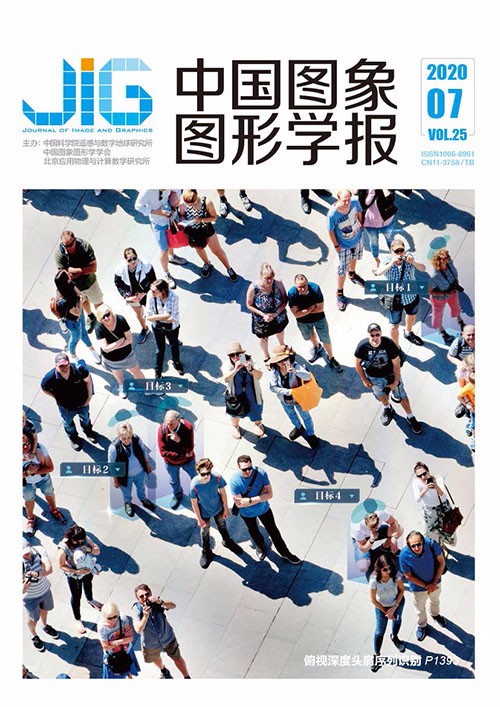
基于水动力学、分数阶微分及Steger算法的线状目标提取
(1.长安大学, 西安 710064;2.西安航空职业技术学院, 西安 710089;3.黎明职业大学智能制造工程学院, 泉州 362000) 摘 要
目的 线状目标的检测具有非常广泛的应用领域,如车道线、道路及裂缝的检测等,而裂缝是其中最难检测的线状目标。为避免直接提取线状目标时图像分割难的问题,以裂缝和车道线为例,提出了一种新的跟踪线状目标中线的算法。方法 对图像进行高斯平滑,用一种新的分数阶微分模板增强图像中的模糊及微细线状目标;基于Steger算法提出一种提取线状目标中心线特征点的算法,避免了提取整体目标的困难;根据水动力学思想将裂隙看成溪流,通过最大熵阈值处理后,先进行特征点的连接,再基于线段之间的距离及夹角进行线段之间的连接(溪流之间的融合)。结果 对300幅裂缝图像及4种类别的其他线状目标图像进行试验,并与距离变换、最大熵阈值法+细线化Otsu阈值分割+细线化、谷底边界检测等类似算法进行比较分析,本文算法检测出的线状目标的连续性好、漏检(大间隙少)和误检(毛刺及多余线段少)率均较低。结论 本文算法能够在复杂的线状目标图像中准确快速地提取目标的中心线,一定程度上改善了复杂线状目标图像分割难的问题。
关键词
Linear object extraction based on hydrodynamics, fractional differential and Steger algorithm
Chen Weiwei1,2,3, Wang Weixing1,2, Li Runqing1,2, Cai Xiaoyan1,2, Zheng Sifan4(1.Chang'an University, Xi'an 710064;2.China;3.Xi'an Aeronautical Polytechnic Institute, Xi'an 710089, China;4.Intelligent Manufacturing Engineering College, Liming Vocational University, Quanzhou 362000, China) Abstract
Objective In all the 2D image segmentation, the objects in an image can be generally classified into area objects and linear objects. The two kinds of object extraction or detection are different, comparing to area object extraction, since the linear object is more elongated, discontinuous based algorithms may be more suitable to use, but vague or tiny edges can be easy lost, which will make the under-segmentation problem. The linear target detection has a very wide range of applications, such as lane line detection in transportation, road extraction in aerial images and remote sensing images, rock fracture analysis in rock engineering, and cement cracks and asphalt cracks in building and road construction applications. In all the linear object extraction or identification applications, the crack detection in an image is one of the most difficult linear object detection. In order to avoid having the difficulty for extracting linear objects directly and accurately, and to solve the problem of crack image segmentation, a new image segmentation algorithm for tracking crack central line is proposed. Method The new algorithm includes three aspects, namely, 1) After image smoothing using a Gaussian filter, an improved fractional differential function is applied to enhance small and vague cracks. This function has nonzero coefficient compared with traditional Tiansi template, indicating that every neighboring pixel of the testing pixel is used for the central feature point detection; 2) Based on that a crack can be regarded as a river/creep, the crack is of a V shape, and the central line in a crack or river is the deep water line, hence, we try to detect the central lines of cracks. The pixels in the central line are called the feature points in this paper. The feature point extraction of crack central lines is based on Steger algorithm and crack image characteristics, where a 1D curve is extended to a 2D ridge or valley line. Then these structures are modeled using a 1D curve, and the feature point is in the direction when it is a curve feature point: the first derivative is zero, the second derivative takes the extreme value, and the feature points are extracted; 3) Considering the distance between the feature points, short gaps between the neighboring segments or points are connected by a line, and long gaps are filled in a optimal routine based on the basis of the gap length and segment angles. We consider that the extraction of cracks in an image is equivalent that a blind man go to find out rivers/creeks on a silt, he will be first step by step to check if there is a deep water point in his current local area, then mark these points and judge which points belong to the same river/creek, finally makes point connection. We assume that a rough and slender crack in a pavement image is a creek or river filled by water, and the boundary of the crack is the side wall. When the feature points of the crack are obtained, the remaining tasks are to connect adjacent feature points and fill crack central line gaps using the idea of water flow-hydrodynamic theory. Result We selected 300 pavement crack and 300 other linear object images in the experiments. Compared with the other four similar traditional algorithms, such as distance transformation, maximum entropy, Otsu, Canny and valley edge detection image segmentation algorithms, the proposed algorithm produces less gaps on the central lines of linear objects or cracks and has less over-segmentation and under-segmentation problems. Conclusion The proposed algorithm can be used in complex linear object and rough pavement crack images because it can rapidly and accurately extract the central line and overcome the existing image segmentation problems for linear object images.
Keywords
|



 中国图象图形学报 │ 京ICP备05080539号-4 │ 本系统由
中国图象图形学报 │ 京ICP备05080539号-4 │ 本系统由